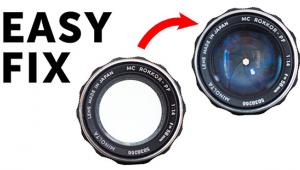Confronting Lens Aberrations, Distortions, and Things that Go Bump in the Night: Or Why You Want To Purchase A High-Quality Lens

All Photos © Jon Sienkiewicz
What happens when light passes through a lens? Why do some lenses yield fuzzy results, even at f/22? What’s the real difference between a good lens and a mediocre one?
Photographers depend on the physical characteristics of light to apply their craft, yet the average Joe knows surprisingly little about how light works. It’s not necessary to be an optical engineer to take great photos, but having a basic grounding in the physics of light could help you understand some of the defects found in nearly all lenses (to one degree or another) and the effect that imperfections have on images.
Light is electromagnetic radiation that reaches our planet from everywhere in the universe but primarily from the sun. Humans perceive a very small portion of this constant bombardment as color. Each color has a different wavelength and frequency—the higher the frequency, the shorter the wavelength. In a vacuum, wavelength times frequency equals the speed of light. Got all that? Good.
When light meets an object it either bounces off, gets absorbed, or passes through—and very often does all three. A solid red barn, for instance, absorbs every color except red, which it reflects—that’s why the barn appears red to our brain. (You notice I didn’t say “eyes,” I said brain. More on that later.) When light reaches a car windshield, some is reflected, some absorbed (the UV, most notably), and much passes through.

The Science Of Light
It’s difficult—some say impossible—for humans to evaluate light objectively without scientific instruments. Our brains have a certain notion about the colors that things are supposed to be. If the data collected by our eyes disagrees with the brain’s preconceived notion, the brain changes the data. For instance, a sheet of common copy paper is supposed to be white, so we perceive it as white, even when it’s illuminated by normal tungsten household light bulbs. You might say that our brain “supplies the missing colors.” But if you photograph that copy paper using daylight-balanced film, the photo is rendered—you guessed it—rusty reddish brown.
During the picture-taking process, light travels through air (and airborne smog, fog, and dust) and strikes the camera’s lens. Some of the light is lost (reflected), some is absorbed, and most is transmitted. When light passes through the boundary between two different types of media (air and glass, for example) it bends or refracts in a predictable way. Light changes speed as it moves from one medium to another.
Transparent material like the glass used in lens making has an Index of Refraction that correlates to the angle that light is bent as it passes through. The angle varies with the wavelength, which is another way of saying that different colors of light bend at different angles. For example, a perfect vacuum has a refractive index of 1.00 and fluorite of about 1.40. By definition, light travels 1.4 times slower through fluorite than through a vacuum. The tendency for different wavelengths (colors) to bend at different angles when passing through the same medium is called dispersion.

Lens “Abnormalities” And The Dreaded Purple Fringe
It’s important to emphasize that the phenomena we label “aberrations” for the most part aren’t really abnormalities at all. Light always does exactly what it’s supposed to do. When it passes through a prism, for example, it breaks down into a rainbow-like spectrum. When we’re trying to focus light on one point, it’s nearly impossible to rein in that dispersion. Because light isn’t doing what we ideally want it to in this instance, we call the result Chromatic Aberration, or CA. It occurs when a lens is unable to focus red, blue, and green wavelengths on the same point. Lateral CA appears as red-green or blue-yellow fringe. Axial CA is purple or green.
The DPF (Dreaded Purple Fringe) that we sometimes see along the edges of strongly backlit objects is usually CA, but not always. There are other possible causes, but since most of us are not scientists, we often go with the easiest explanation first. The weird violet glow can also be caused by CCD charge leakage, by reflections that occur inside the lens or from the rear element of the lens reflecting off the CCD.
The color bleed caused by lens-to-lens or lens-to-sensor reflections is minimized in today’s modern optical designs by the application of precisely formulated lens coatings. The appearance of CA is effectively squelched in better compact cameras by the image-processing engine which uses on-board firmware to correct for other undesirables like barrel and pincushion distortion as well. And of course, most of the damaging discoloration caused by CA can be reduced or eliminated entirely by using any of the popular image file editors like Photoshop.

Types Of Lens Aberrations
Here are some other lens aberrations you may have read about.
When light rays traveling parallel to the optical axis but at different distances from the center do not converge on the same point we have Spherical Aberration. This is corrected somewhat easily by grinding the lens element into the proper shape or by using symmetric doublets. This is one reason lenses are built using several individual elements assembled into groups.
Field Curvature causes flat objects to project curved images. This is a sticky one because it often appears as Wavy Curvature, which causes lenses to look sharp in the center and at the edges, but a bit fuzzy in between. Macro lenses are highly corrected for curvature. Other lenses improve when stopped down to a midrange aperture.
Coma occurs when light enters the front of the lens from an angle and appears very similar to CA. Because the severity of coma correlates to the distance from the edge of a lens to the axis (center), lenses with large front elements suffer more readily. Coma is corrected by adding lens elements in the right places.
Two types of distortion that we all know and hate are Pincushion and Barrel Distortion, so named because of the appearance they give to a square subject. Both are commonly produced by lower quality lenses and both can be corrected fairly easily with Photoshop.
Sweet Spots
Lenses improve when we stop them down by selecting a smaller aperture, but have you ever wondered why they get worse if we stop them down too much? We can thank diffraction for that. Light waves spread out when they pass through a small opening like the aperture diaphragm in a lens.
Most lenses have a “sweet spot” that’s usually two or two and one half stops smaller than the maximum aperture. (Kudos to Pentax for providing a Program mode that defaults automatically to the sweet spot of a given lens.)
Better lenses use sophisticated optical designs and expensive glass materials with precisely calculated refractive indices to minimize the negative effects of aberrations. When you buy a $99 telephoto zoom you get what you pay for. If you use your telephoto only a few times a year to photograph the squirrel in your backyard, you probably don’t need a more highly corrected (and therefore more expensive) piece of glass. But then, don’t complain when that squirrel has a purple halo.
- Log in or register to post comments

















































